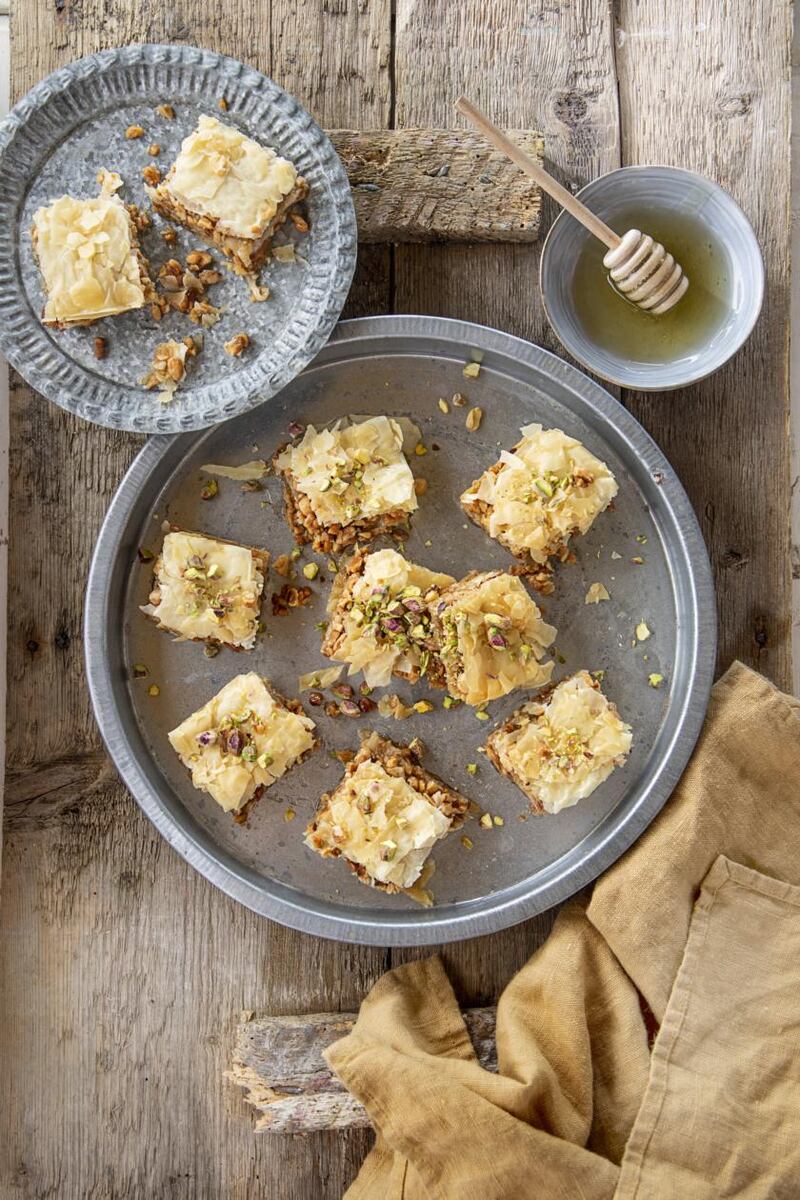I was lucky to visit Baghdad before the Gulf war, when it had a thriving community of Irish expatriates. Strolling through the atmospheric souks at night was an unforgettable experience, with hawkers selling flatbreads and nuts toasted over the glow of live-coal braziers.
I tasted baklava for the first time. There is something magical about baklava. Layers of the thinnest pastry, filled with chopped nuts and soaked in aromatic syrup. What is it about these sticky squares of nutty goodness? The flavours and textures are so unique. The filling of sweet cinnamon scented chopped nuts, usually pistachios, almonds or walnuts, is irresistible.
Baklava is so dense and sweet it must be served in tiny portions and yet it even seduces people who don’t normally have a sweet tooth. This is quite a feat for a dessert which is soaked in sugar syrup. Perhaps it is because you must savour each bite, knowing it could be gone in seconds.

The syrup in a traditional baklava is usually flavoured with rose water or orange blossom water. Baklava made with flower water has an enticing depth of flavour which lifts it far beyond the ordinary. It is also good with a straightforward sugar syrup though, and perhaps more likely to appeal to children that way. Too much flower water can be overpowering, so if you’re unsure, add it to the syrup a teaspoonful or two at a time until you’re happy with the taste.
Other aromatics can be added to the sugar syrup such as cinnamon sticks, cardamom pods or star anise.
The real challenge with baklava is cutting through the brittle filo pastry. To make neat portions without shattering the pastry into countless pieces, it is very helpful to cut the baklava before baking it.
Pre-cutting also means when you come to add the syrup after baking, you can concentrate on pouring it into the cuts. This means the syrup soaks every portion equally and no one has to fight over the sticky edge pieces. This is definitely a dessert to pass around the table, so people can scoop up any extra sauce left swimming in the tin.

BAKLAVA
Makes 12
Ingredients
300g chopped nuts (pistachios, walnuts)
2 tsp ground cinnamon
200g-300g filo pastry sheets, thawed
175g melted butter
For the syrup
75g caster sugar
175ml water
200g honey
1 tbsp lemon juice (or 1 tsp orange blossom water)
Variation
Pistachio nuts add a great flavour and colour, but as they are expensive, it is economical to blend with walnuts or blanched almonds.
Method
1. Preheat an oven to 160 degrees Celsius fan, or equivalent. Grease the base and sides of a rectangular baking tin (approximately 23cm x 33cm). If not already chopped, set aside a tablespoon of pistachio nuts and chop separately (the green coloured nuts look pretty when sprinkled over the finished baklava).
2. Chop the nuts in a food processor to a coarse breadcrumb texture (or chop with a sharp knife). Combine the nuts and cinnamon together.
3. Unwrap the filo pastry, count the number of layers, but keep it covered under a damp tea towel to stop it drying out. Melt the butter and have a pastry brush to hand.
4. Lay a sheet of filo pastry on the base of the baking tin and brush with melted butter before placing the next sheet on top. Having counted the sheets of filo, layer a third of the filo sheets on top of each other, brushing butter between layers. Stop after a third of the sheets have been used.
5. Spread with half the nutty mixture, then once again cover with another set of buttered filo sheets.
6. Spread with the remainder of the nut mixture and cover with the remaining filo pastry sheets. Brush the top sheet with melted butter. Use a sharp knife to divide the entire baklava into portions (you can cut it into diamonds or squares).
7. Bake in the preheated oven for 45-60 minutes, until the pastry looks golden brown and crisp. Remove when cooked.
8. While the baklava is in the oven, make the syrup. Place the sugar, water, honey and lemon juice in a heavy based saucepan, bringing the syrup to a boil, then allow to simmer for 10 minutes on a low heat without stirring; it should be thickened and syrupy.
9. When the baklava is baked, remove from the oven and pour the hot syrup evenly over the baked pastry. Allow to stand for at least two hours uncovered. Sprinkle with any reserved chopped pistachios. Keep stored at room temperature in an airtight container for up to 3-4 days.










